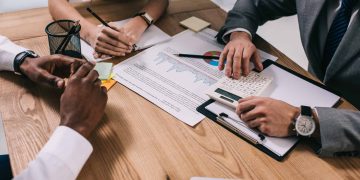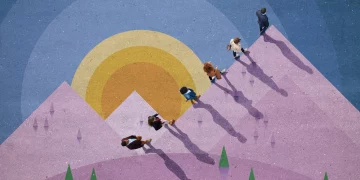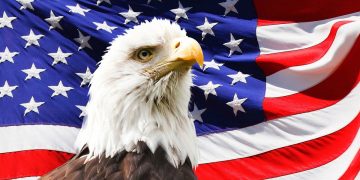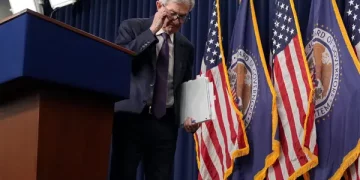The Tide of Interest Rates:
A Straining Financial Climate
In an economic landscape where sustained higher interest rates have become the norm, a greater number of borrowers are finding themselves grappling with financial difficulties. Rising inflation means that central banks may have to maintain higher policy rates, impairing borrowers’ capacity to service their debts.
The Author’s Insight:
Economic Resilience and Risks
Penned by Tobias Adrian on October 10, 2023, the text examines a period of intense interest rate hikes by central banks worldwide to curb inflation―a trend that might persist. Since late 2021, policymakers from advanced economies have hiked rates by an average of around 400 basis points, while emerging markets have seen an average increase of approximately 650 basis points.
Monetary Consequences:
Economies Under Pressure
Most economies have been absorbing the brunt of these drastic policy tightenings, demonstrating resilience over the past year. Yet, core inflation remains high in some economies, particularly in the US and parts of Europe, which may necessitate maintaining elevated interest rates over an extended period.
Global Financial Stability Report:
A Precarious Balance
Outlined in the “Global Financial Stability Report,” the current risks bear a downward bias. Though vulnerabilities are akin to assessments from April, acute stress witnessed in certain banking systems has abated. However, newfound signs of distress have surfaced, not least among those being the waning debt servicing capacity of individual and corporate borrowers—a harbinger of credit risk.
The Erosion of Buffers:
Businesses and Households Tapping Reserves
During the pandemic, many businesses, while having to shutter, managed to emerge with robust cash buffers, partly thanks to fiscal support from various nations. However, prolonged high interest rates pose a risk as revenues decline and debt servicing costs soar, prompting businesses to tap into these reserves.
The “Global Financial Stability Report” indicates a growing chunk of small and mid-sized enterprises, in both developed and emerging markets, with barely enough cash to cover interest expenses. Default rates in the leveraged loan market are trending upwards, and with over $5.5 trillion in corporate debt maturing in the coming year, the situation could exacerbate.
The Domestic Front:
Households and Real Estate in Flux
Households, too, have been depleting their buffers. Excess savings in developed economies have steadily diminished from last year’s peaks of 4% to 8% of GDP. Concurrently, delinquency rates for credit card and auto loans appear to be rising.
The real estate sector is facing its challenges: residential mortgages, typically the largest category of household borrowing, now endure rates significantly higher than a year prior, further eroding savings and pressurizing the property market. In nations dominated by floating-rate mortgages, rapid increases in rates have precipitated mortgage payment issues, leading to significant droops in housing prices. Commercial real estate suffers similar strains: rising rates have dried up financing sources, hampered transactions, and lifted default rates.
Higher rates also pose challenges for governments. Frontier countries and low-income nations encounter increased borrowing difficulties as foreign investors demand higher returns for currency loans in euros, yen, dollars, and pounds. This year’s hard currency bond issues bear higher coupon rates, yet worries over sovereign debt extend beyond low-income countries, as spikes in developed economies’ long-term rates reveal.

Market Sentiment:
Investor Optimism vs. Rising Risks
Despite obvious repayment tribulations among borrowers, investors seem largely unfazed. Stock and bond markets remain robust, with financial conditions easing, fueled by expectations of a “soft landing” in the global economy — i.e., central banks’ interest rate hikes successfully quelling inflation without triggering a recession.
This optimism presents dual dilemmas: persistently lenient financial conditions could continue to stoke inflation, and if adverse events escalate—like an intensifying conflict in Ukraine or mounting challenges in China’s real estate sector—interest rates could sharply tighten.
A sudden clampdown on financial conditions adds stress to the more fragile banks already facing heightened credit risks. In some nations, investigations suggest a tapering in bank lending, with elevated borrower risk featuring largely. As forthcoming discussions in the “Global Financial Stability Report” will explore, a scenario combining high inflation, high-interest rates, and an ensuing global recession could see many banks incurring substantial equity losses. Should banks’ market values fall below the book value of their balance sheets, scrutiny into their prospects by investors and depositors could prompt financing issues for vulnerable institutions. Similar fragilities exist within non-bank financial intermediaries, such as hedge funds and pension funds.
Mitigating Measures:
Policy Makers at the Helm
Fortunately, policy creators have the tools to fend off adverse outcomes. Central banks across countries must maintain the resolve to bring inflation back to target levels, as price stability is essential for sustained economic growth and financial stability. If financial equilibrium comes under threat, policymakers should promptly employ liquidity supports and other instruments to mitigate acute stress and restore market confidence. Lastly, in light of the significant role healthy banks play in the global economy, authorities also need to strengthen regulatory supervision of the financial sector further.









































